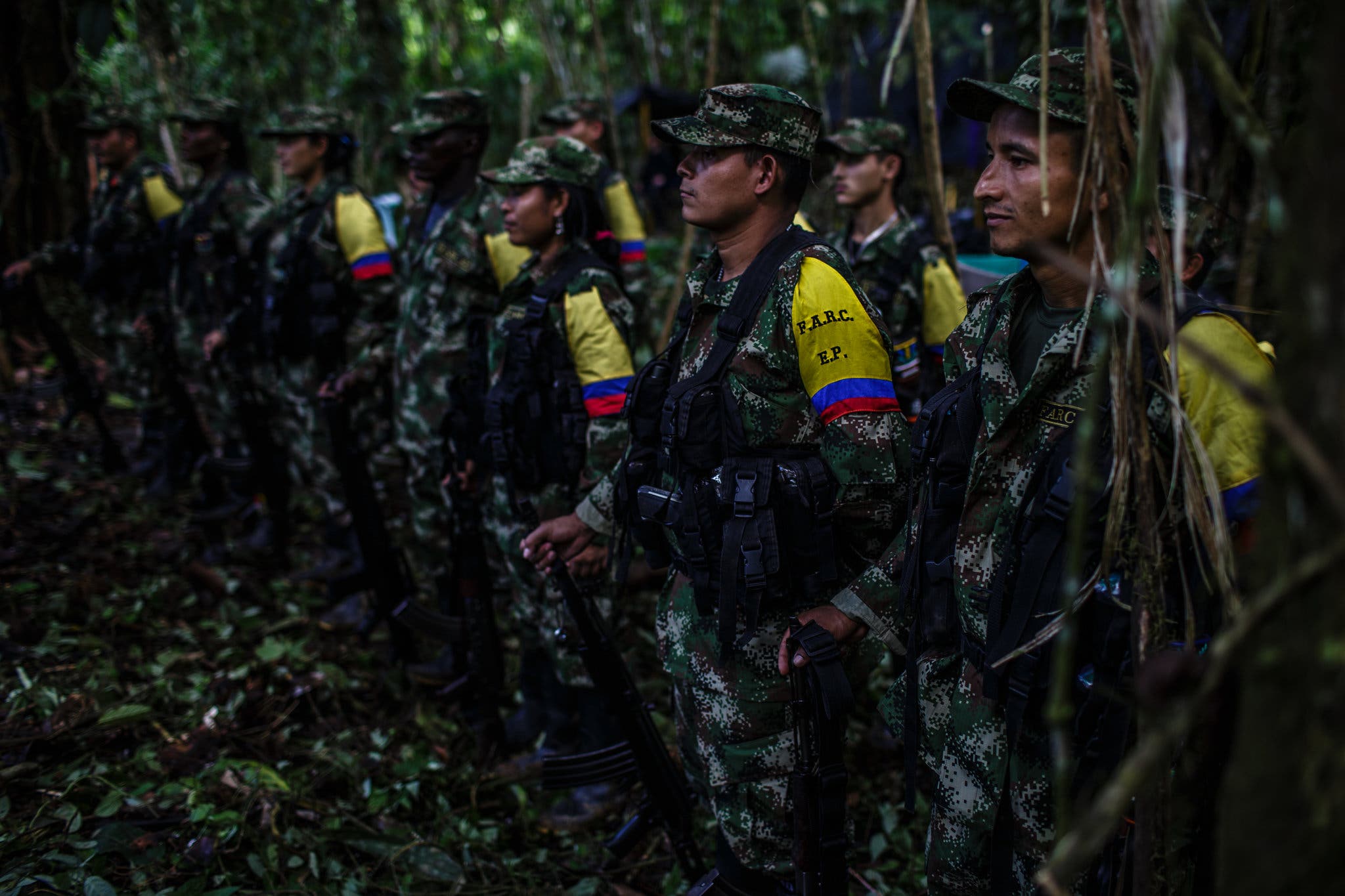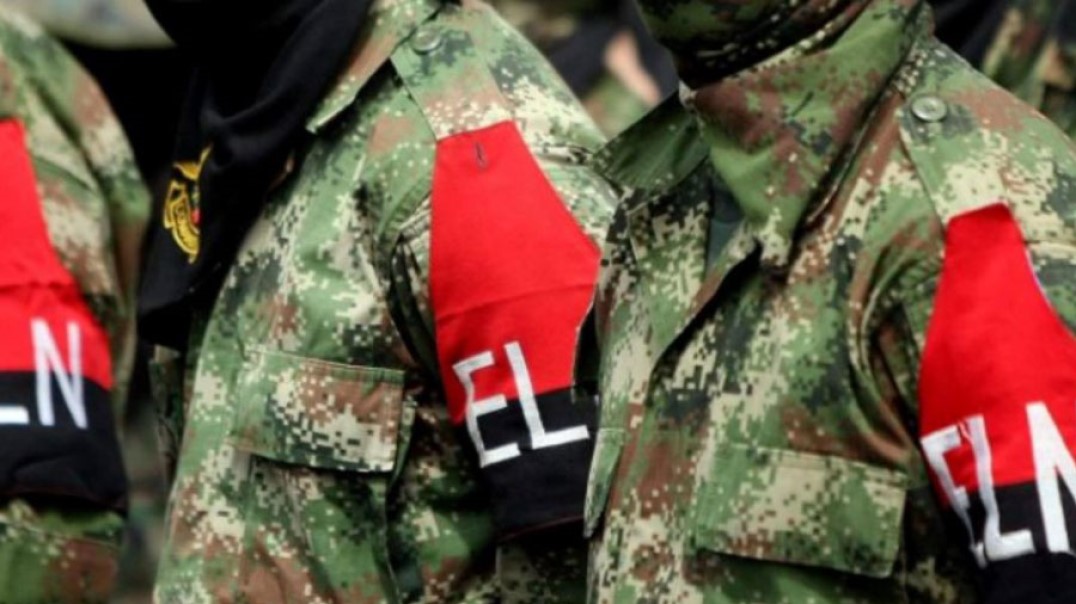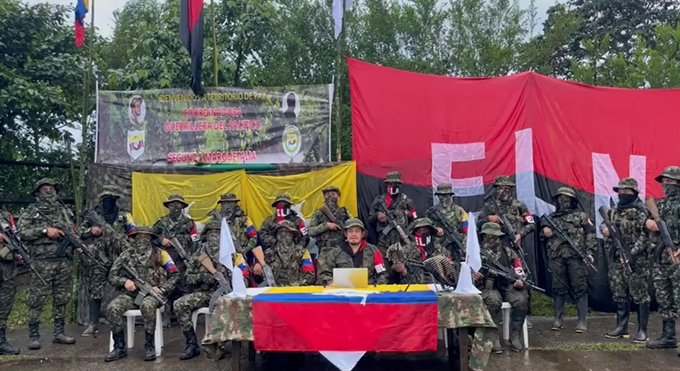An Agreement With Ideological Allies:
An alliance between the Revolutionary Armed Forces of Colombia (FARC) and Colombia’s National Liberation Army (ELN) was brokered on Saturday in the department of Nariño after decades of conflict between the two paramilitary groups.
A video published by the FARC stated that the two would enter into an “agreement of unity and coordination” as they held the same goals for Colombia. The video featured members of the paramilitary groups armed and in their respective uniforms, while a spokesman affiliated with the ELN read the statement.
An alliance between the Revolutionary Armed Forces of Colombia (FARC) and Colombia's National Liberation Army (ELN) was brokered on Saturday in the Department of Nariño.
Read Here: https://t.co/RlkNXD6m4I
Video via Nariño Televisión#FARC #ELN #Colombia pic.twitter.com/VIVKG1aXdf
— Trent Barr (@Atlas_Trent) January 17, 2024
“The two guerrilla political-military forces announce that in the department of Nariño we have reached an agreement of unity and coordination, understanding that both historical roots as sister organizations have the same goal, aimed at the solution of the serious social problem that suffers and affects the Colombian people,” the ELN spokesman stated.
The spokesman further stressed that the groups still sought to maintain a “commitment of dialogue with the government and with the Total Peace of Gustavo Petro” and invite the populations to be part of the regional peace dialogues in Nariño to “solve the problems” of the department.
Nariño is a department located in southern Colombia that has been hotly contested by various criminal organizations, including the FARC and the ELN.
An Alliance Amid a Ceasefire:
The alliance comes amidst a meeting between leaders of the FARC and President Gustavo Petro’s administration to extend a ceasefire originally agreed upon in October between the two groups that was set to expire this month on Monday, January 15th, in an effort to reduce violence targeted at rural Colombians.
The ceasefire is the latest attempt by President Petro to bring about “total peace” between the Colombian government and the various paramilitary groups that operate within the nation’s borders and bring an end to the 60-year conflict, which has led to the deaths of an estimated 450,000 people.
“The cease-fires we have seen (during the Petro administration) so far have really only limited the clashes between the government and the rebel groups, but haven’t had a real impact on the lives of communities,” Elizabeth Dickinson, a Colombia analyst at the International Crisis Group, told the Associated Press. “What we get to see now is whether this ceasefire can change that paradigm.”
The newly agreed-upon terms of the ceasefire include the FARC ceasing hostile actions against rural Colombians, such as threatening community leaders and impeding the movement of villagers.

However, previous ceasefires have not ended violence against Colombian civilians, as both the FARC and the ELN have continued a multitude of criminal schemes, including operating illegal mining sites, drug trafficking, and the kidnapping and ransoming of civilians, which previously included a world renown football player’s father.
Despite the continued criminal operations of the two groups, Colombia saw a decrease in homicides since the 2016 FARC-government ceasefire, which saw the majority of the FARC disarm and disband before forming their own political party. While homicides have gone down overall, violence in rural areas of Colombia has increased as the remnants of the FARC fight for control of such territories, as clashes with other criminal organizations have previously been reported.
The Colombian government has previously made peace with the ELN in a ceasefire negotiated in June and initiated in August which is set to expire in February.
The Future of the FARC:
An alliance between the FARC and the ELN amid a ceasefire with government forces could promise a decrease in violence in rural Colombia. However, some worry that two of the country’s major criminal organizations entering an alliance could change the landscape of Colombia’s underworld for worse.
Critics of President Petro’s plan for “total peace” have also raised concerns that the peace deal may allow both the FARC and the ELN to continue to engage in criminal activities without repercussions.
It is unclear how long the alliance between the two paramilitary groups will last, as both the FARC and the ELN have previously broken agreements with the Colombian government, leading some to question the longevity of an alliance.
The Groups in Question:
The Revolutionary Armed Forces of Colombia are a Marxist-Leninist paramilitary group originally formed in 1966 from various peasant defense groups during the “Violencia” period, a 10-year civil war between Colombia’s Conservative Party and Liberal Party. Despite their peasant origins, the group is known to utilize extortion, drug trafficking, kidnapping, and illegal mining in order to fund their operations. The group disbanded in 2016 and formed a political party; however, a dissident group known as the Estado Mayor Central (EMC) continued its operations against the government. The EMC currently stands at an estimated 3,530 members, with 2,180 fighters and 1,350 auxiliaries.

The National Liberation Army is another Marxist-Leninist paramilitary group and predates the FARC, which was formed in 1964. The bulk of the ELN’s members were students and youth activists instead of the peasant composition of the FARC. The ELN also utilizes similar methods to the FARC in order to fund their operations, including extortion, drug trafficking, and kidnapping.
Peace talks between the ELN and the Colombian government began in 2005 before coming to fruition in 2017, when a ceasefire between the two was negotiated in September and took effect in October, with the ceasefire being set to end in January of 2018. Peace talks would fall apart following the ELN’s bombing in Colombia’s capital of Bogotá, which claimed the lives of 21 people and injured 68 others. This marked the deadliest attack in the capital since the El Nogal Club bombing in 2003 and the first attack on the capital since the Centro Andino bombing in 2017.
Peace talks reinitiated when Colombia’s current president, Gustavo Petro, took office in 2022, where the new government and the ELN met in Venezuela and negotiated a ceasefire that lasted from December 24, 2022, to January 2, 2023, with various other ceasefires being negotiated as time went on.



